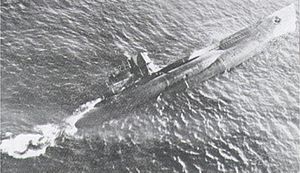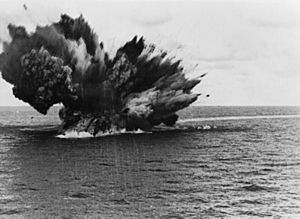Mediterranean U-boat campaign of World War II facts for kids
Quick facts for kids Mediterranean U-boat Campaign |
|||||||
|---|---|---|---|---|---|---|---|
| Part of the Battle of the Mediterranean of the Second World War | |||||||
 U-617 aground near Mellila, Morocco, at position 35°23′N 3°16′W / 35.38°N 03.27°W after British air attack on 12 September 1943 |
|||||||
|
|||||||
| Belligerents | |||||||
Other Allied navies |
|||||||
| Strength | |||||||
| 62 U-boats | |||||||
| Casualties and losses | |||||||
| 95 merchant ships sunk 24 big warships sunk |
62 U-boats lost | ||||||
The Mediterranean U-boat Campaign was a part of World War II that took place in the Mediterranean Sea. It lasted from September 1941 to May 1944. During this time, German submarines, called U-boats, tried to stop Allied ships from moving supplies across the sea.
The British base on the island of Malta was very important. It was located near the main shipping routes from Europe to North Africa. The Axis powers (Germany and Italy) needed to send supplies to their armies in North Africa. However, their supply ships often suffered heavy losses. Meanwhile, the Allies were able to keep their armies in North Africa well-supplied.
The German navy, known as the Kriegsmarine, first tried to cut off Malta. Later, they focused on stopping Allied landings in southern Europe. Sending U-boats into the Mediterranean was risky. The Straits of Gibraltar were a narrow passage where U-boats could easily be found and attacked. The Mediterranean Sea is also very clear and calm, which made it harder for U-boats to hide and escape.
Contents
Early U-boat Missions
The German navy had some experience in the Mediterranean from World War I and the Spanish Civil War. In World War I, a German U-boat commander named Karl Dönitz (who later led the U-boat fleet) had served there. German U-boats also secretly helped the Nationalists during the Spanish Civil War in 1936. These early missions helped the Germans learn about the area.
In 1939, Dönitz tried to send three long-range U-boats into the Mediterranean. Their goal was to attack Allied supply ships. However, these missions did not go well. One U-boat, U-25, was damaged and had to return. Another, U-53, ran low on fuel. U-26 faced bad weather and British patrols near Gibraltar. It managed to enter the Mediterranean but didn't sink many ships. U-26 was the only U-boat to enter and leave the Mediterranean during the war. These early attempts showed how difficult it was to operate U-boats in this sea.
U-boats in North Africa
In September 1941, Germany created the 23rd U-boat Flotilla to help their Afrika Korps army in North Africa. U-boats from this group patrolled the eastern Mediterranean from a base in Greece. Later, more bases were set up in Croatia and Italy.
Many U-boats tried to pass through the Strait of Gibraltar to reach the Mediterranean. This was a very dangerous journey. Several U-boats were sunk or damaged during this passage. Once inside, they targeted Allied ships carrying supplies to places like Tobruk and Malta. For example:
- U-81 sank the British aircraft carrier HMS Ark Royal in November 1941.
- U-331 sank the battleship HMS Barham in November 1941.
The Second Happy Time
By May 1942, the U-boats in the Mediterranean were reorganized into the 29th U-boat Flotilla. For a while, fewer new U-boats were sent to the Mediterranean because there were better hunting opportunities off the coast of North America.
The 29th Flotilla focused on stopping convoys (groups of ships) that were supplying Malta and British forces in Egypt. U-boats would spend time on patrol, then return to base for supplies and repairs. It was very risky for single U-boats to patrol alone. If they were found by a group of Allied destroyers, they could be hunted until they ran out of air or battery power.
- U-73 sank the British aircraft carrier HMS Eagle in August 1942.
- U-77 sank several ships and damaged others while patrolling near Cyprus and Lebanon.
- U-565 sank the British cruiser HMS Naiad in March 1942.
Allied Invasion of North Africa
As the Allies improved their ways of finding and attacking submarines, more U-boats were sent to the Mediterranean. This was especially true when the Allies planned to invade North Africa in an operation called Operation Torch.
German U-boats gathered in groups, called wolfpacks, near the invasion areas. They tried to stop the Allied invasion convoys. However, the Allies had strong defenses. For example, when U-559 was found by a British plane, five destroyers hunted it for ten hours. The U-boat was forced to surface and its crew abandoned ship. The British managed to get important German code documents from the sinking U-boat.
During the invasion, five U-boats were sunk while trying to stop the Allies.
- U-331 sank the American transport ship USS Leedstown in November 1942, but was sunk itself soon after.
- U-617 sank the British minelayer HMS Welshman in February 1943.
Axis Defeat in Tunisia
As Allied armies pushed through North Africa and into Sicily, they built more airfields. This meant more Allied planes could spot U-boats. The 29th Flotilla moved its main base to Toulon in France in August 1943. They continued to attack Allied supply convoys.
The Allies developed a tactic called Swamp. This meant that if a U-boat was found, a team of escort ships would hunt it down until it was destroyed or forced to surrender. U-boats tried to use new torpedoes that could home in on destroyers, but they struggled against these organized Allied attacks.
- U-97 was sunk by a British plane in June 1943.
- U-375 was sunk by an American submarine chaser in July 1943.
- U-617 was sunk by British planes in September 1943.
After Italy Surrendered
When Italy surrendered in September 1943, the situation became even harder for the German U-boats. Allied forces became even stronger in the Mediterranean. U-boats that stayed in port were often attacked by American planes.
When the Allies invaded southern France in August 1944 (Operation Dragoon), the U-boat base at Toulon had to be closed. The remaining U-boats there were sunk by their own crews to prevent them from being captured. Three U-boats remained at the Salamis base in Greece until September 1944, when Allied forces reached them.
- U-73 was sunk by a convoy escort in December 1943.
- U-81 was destroyed by an American air raid in January 1944.
- U-371 sank several ships and damaged others before being hunted down and sunk in May 1944.
- U-410 sank two ships and damaged others before being destroyed by an American air raid in March 1944.
Results of the Campaign
During the Mediterranean U-boat Campaign, German U-boats sank 95 Allied merchant ships and 24 Allied warships. These warships included two aircraft carriers, one battleship, four cruisers, and 12 destroyers.
However, the Germans paid a high price. A total of 62 U-boats were lost in the Mediterranean. This was a significant loss for the German navy. The Allies ultimately won the campaign, successfully keeping their supply routes open and defeating the Axis forces in North Africa.
U-boats Sunk by Allied Submarines
Four German U-boats were sunk by Allied submarines in the Mediterranean:
- U-95 was sunk by a Dutch submarine in November 1941.
- U-301 was sunk by a British submarine in January 1943.
- U-303 was sunk by a British submarine in May 1943.
- U-374 was sunk by a British submarine in January 1942.
See also
- Military history of Gibraltar during World War II
- 29th U-boat Flotilla


